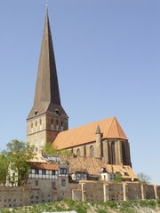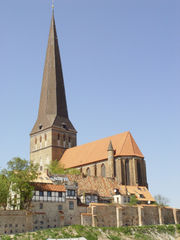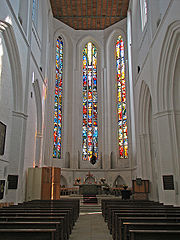
St. Petrikirche, Rostock
Encyclopedia
St. Peter's Church, in German
Petrikirche, is the oldest of three town churches found in the Hanseatic
city of Rostock
, in northern Germany
. The other two are St. Mary`s Church (Marienkirche) and St. Nicholas (Nikolaikirche). A fourth, St. Jakobi, was heavily damaged during the Second World War and subsequently demolished.

, a building style typical of the Hanseatic port cities of northern Germany.
again damaged the church and led to the collapse of the polygonal spire
.
.
 The church is a three-nave Basilica with a high cross-vaulted ceiling in the west tower. On the north and south façade 4 times over are ever-alternating round arched arcades each with a large rectangular window. in the central aisle of the tower 3 high round arched arcades are on each side except the eastern side, where the tower joins the Basilica, at each of the four points there are 3 round-arched windows. The choir section is polygonal; at the north and south end is one small fiale with a pointed tip. The design of the dividing inner-wall (zweizonige) exhibits the round-arched arcade design typical of Roman-Gothic style. Prior to WWII damage, the arched gallery was open. However, it was only roughly rebuilt when reconstruction began. The light coming in from the large rectangular windows, flows over the gallery. The cross-ribbed vaulted ceiling that covers the northern end of the nave is preserved. However, the southern nave was too badly damaged to reconstruct the original. Also, the central nave couldn’t be restored, so instead a flat-timbered ceiling was put in place. The baroque decoration in the interior of the church was destroyed by fire during the WWII bombing of Rostock on the night of 26th and 27 April 1942. The stained glass windows of the choir are decorated with scenes from the life of St. Peter and were designed in the early 60s by local artist Lothar Mannewitz (1930–2004).
The church is a three-nave Basilica with a high cross-vaulted ceiling in the west tower. On the north and south façade 4 times over are ever-alternating round arched arcades each with a large rectangular window. in the central aisle of the tower 3 high round arched arcades are on each side except the eastern side, where the tower joins the Basilica, at each of the four points there are 3 round-arched windows. The choir section is polygonal; at the north and south end is one small fiale with a pointed tip. The design of the dividing inner-wall (zweizonige) exhibits the round-arched arcade design typical of Roman-Gothic style. Prior to WWII damage, the arched gallery was open. However, it was only roughly rebuilt when reconstruction began. The light coming in from the large rectangular windows, flows over the gallery. The cross-ribbed vaulted ceiling that covers the northern end of the nave is preserved. However, the southern nave was too badly damaged to reconstruct the original. Also, the central nave couldn’t be restored, so instead a flat-timbered ceiling was put in place. The baroque decoration in the interior of the church was destroyed by fire during the WWII bombing of Rostock on the night of 26th and 27 April 1942. The stained glass windows of the choir are decorated with scenes from the life of St. Peter and were designed in the early 60s by local artist Lothar Mannewitz (1930–2004).
German language
German is a West Germanic language, related to and classified alongside English and Dutch. With an estimated 90 – 98 million native speakers, German is one of the world's major languages and is the most widely-spoken first language in the European Union....
Petrikirche, is the oldest of three town churches found in the Hanseatic
Hanseatic League
The Hanseatic League was an economic alliance of trading cities and their merchant guilds that dominated trade along the coast of Northern Europe...
city of Rostock
Rostock
Rostock -Early history:In the 11th century Polabian Slavs founded a settlement at the Warnow river called Roztoc ; the name Rostock is derived from that designation. The Danish king Valdemar I set the town aflame in 1161.Afterwards the place was settled by German traders...
, in northern Germany
Germany
Germany , officially the Federal Republic of Germany , is a federal parliamentary republic in Europe. The country consists of 16 states while the capital and largest city is Berlin. Germany covers an area of 357,021 km2 and has a largely temperate seasonal climate...
. The other two are St. Mary`s Church (Marienkirche) and St. Nicholas (Nikolaikirche). A fourth, St. Jakobi, was heavily damaged during the Second World War and subsequently demolished.

Building
St. Peter's Church was built in the middle of the 14th century. The first reference to a church on this site is in 1252, which is thought to be the predecessor of the current building. The triple-nave basilica is in Brick GothicBrick Gothic
Brick Gothic is a specific style of Gothic architecture common in Northern Europe, especially in Northern Germany and the regions around the Baltic Sea that do not have natural rock resources. The buildings are essentially built from bricks...
, a building style typical of the Hanseatic port cities of northern Germany.
Damage
The pre-existing church had a tower 127m (413 feet) high which was destroyed by a thunderbolt in 1543. In 1578 the tower was rebuilt as a polygonal spire after it had been, once again, damaged by storm. With a height of 117m (380 feet) the tower served as a familiar landmark in the local area. In the following centuries the church decayed and in 1902 the Basilica was renovated. Forty years later, however, heavy bombing during World War IIWorld War II
World War II, or the Second World War , was a global conflict lasting from 1939 to 1945, involving most of the world's nations—including all of the great powers—eventually forming two opposing military alliances: the Allies and the Axis...
again damaged the church and led to the collapse of the polygonal spire
Spire
A spire is a tapering conical or pyramidal structure on the top of a building, particularly a church tower. Etymologically, the word is derived from the Old English word spir, meaning a sprout, shoot, or stalk of grass....
.
Re-building
Following the war, the building was gradually rebuilt. Today the church, roofed by a flat timber ceiling, reaches a height of 24m (78 feet) and in 1994 a glass window in the choir was built to a height of 17m (55 feet). Public donations funded the building of a copper polygonal spire and this allowed St. Peter's to once again become a visible landmark in the surrounding area. Additionally, a 45m (146 feet) observation platform (accessed via steps and an elevator) provides fine views of the city of Rostock and the Baltic SeaBaltic Sea
The Baltic Sea is a brackish mediterranean sea located in Northern Europe, from 53°N to 66°N latitude and from 20°E to 26°E longitude. It is bounded by the Scandinavian Peninsula, the mainland of Europe, and the Danish islands. It drains into the Kattegat by way of the Øresund, the Great Belt and...
.
Description


